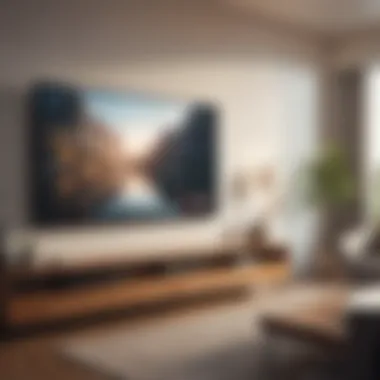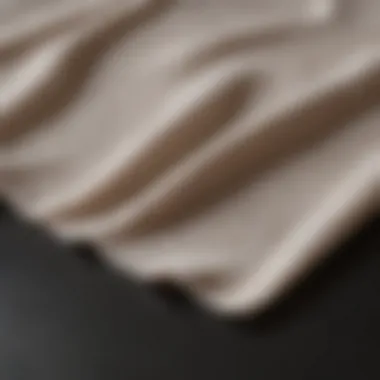Essential Guide to Cleaning Flat Screen TVs


Intro
Cleaning a flat screen TV is a task that often poses challenges for users. Many people worry about damaging their screens while cleaning. It’s essential to understand the right methods and materials before diving into the task. Knowing how to clean your flat screen will enhance its longevity and maintain its visual quality.
This article will provide a detailed guide on the best practices for maintaining a flat screen TV. We will cover the recommended cleaning solutions, effective techniques, and how often one should clean their television. By focusing on practical knowledge, the readers can make informed choices about cleaning their devices.
Investing time in understanding these methods is critical. Not only does it prevent potential damage, but it also ensures the display remains clear and vibrant. Let’s explore the key components of cleaning flat screen TVs effectively.
Understanding Flat Screen Technology
Understanding flat screen technology is essential to grasp the nuances of proper maintenance and cleaning. Each type of flat screen TV has distinct characteristics that impact how they should be cared for. Knowing these details not only aids in preserving the device's functionality but also enhances the viewing experience.
Types of Flat Screen TVs
Technology
LCD, or Liquid Crystal Display, utilizes a backlight to illuminate the liquid crystals that form images. One specific aspect of LCD technology is its affordability and wide availability, making it a popular choice in households. The key characteristic is its ability to produce bright images with good color accuracy.
However, a unique feature of LCD screens is their vulnerability to glare in bright environments. This can lead to a diminished viewing experience. Hence, it is crucial to regularly clean and maintain these screens to ensure optimal picture quality and prolong lifespan.
LED Technology
LED technology is essentially an upgraded version of LCD. Instead of fluorescent backlighting, it uses LED lights, which offer higher brightness and better contrast. This specific aspect contributes to energy efficiency, making LED TVs a favored option.
The key characteristic of LED televisions is their slim profile and vibrant colors. A unique feature is the local dimming capability, which enhances contrast and black levels. However, improper cleaning methods can lead to irreversible damage to the screen surface.
OLED Technology
OLED, or Organic Light Emitting Diode, is at the forefront of display technology. One specific aspect of OLED is its ability to produce true blacks, as each pixel emits its own light. This technology produces stunning picture quality that complements high-definition content.
The key characteristic of OLED screens includes their flexibility and thinness, allowing for innovative designs. A unique aspect is the wide viewing angles, which is advantageous for shared viewing experiences. Meanwhile, these screens can be more expensive and sensitive to burn-in, requiring careful handling during cleaning.
Importance of Screen Maintenance
Maintaining the flat screen television enhances the overall enjoyment of your media experience.
Preserving Picture Quality
One of the most significant aspects of preserving picture quality is keeping the screen free of dust and smudges. Regular cleaning ensures that colors remain vivid and details are sharp. An essential factor is that neglecting this maintenance can lead to poor display performance. It is beneficial to establish a routine that includes periodic assessments of the screen's condition.
Extending Device Lifespan
Extending the lifespan of a flat screen TV often comes down to regular upkeep. When dust and dirt accumulate, they can lead to overheating and reduce the effectiveness of cooling systems. By maintaining a clean screen, you can reduce the likelihood of wear and extend the device’s usability. Regular maintenance translates to lower long-term costs by minimizing the need for repairs or replacements.
Preventing Screen Damage
Preventing screen damage requires awareness of cleaning materials and techniques. Using improper solutions or coarse fabrics can scratch the screen. A proactive maintenance plan includes learning about safe cleaning products and gentle methods. This not only maintains aesthetic appeal but also protects against permanent damage.
Essential Cleaning Supplies
Cleaning a flat screen TV requires diligence and the proper tools. The right cleaning supplies are essential for maintaining the device's condition and ensuring optimal performance. Using inappropriate products can not only be ineffective but can also harm the screen. Therefore, it is crucial to understand what cleaning solutions and tools to use for best results.
Recommended Cleaning Solutions
Commercial Screen Cleaners
Commercial screen cleaners are widely available and designed specifically for electronic displays. These products often include special ingredients that provide effective cleaning without damaging the screen. The advantage of using commercial cleaners lies in their convenience and reliability. They are formulated to cut through dust, fingerprints, and smudges without leaving streaks.
However, one must be cautious about the choices. Some commercial cleaners may contain alcohol or ammonia, which can be harmful to the delicate surface of a flat screen.


Homemade Solutions
Homemade solutions have gained popularity due to their cost-effectiveness and natural ingredients. A simple mix of distilled water and white vinegar can safely clean screens without any harsh chemicals. This approach allows the user to avoid potentially damaging substances, making it a favorite for many. The key feature of homemade solutions is their accessibility and affordability.
Nonetheless, the effectiveness of these solutions might not equal that of specially formulated cleaners, especially for heavy residues. Careful preparation and appropriate dilution are essential for the best results.
Tools for Effective Cleaning
Microfiber Cloths
Microfiber cloths are essential tools when it comes to cleaning screens. Their unique structure allows them to capture dust and dirt without scratching the surface. This feature makes them a popular choice among enthusiasts. Microfiber is capable of absorbing five to seven times its weight in water and is effective for both dry and damp cleaning.
However, it's important to use them clean and avoid mixing with other fabrics, which can lead to scratches on the screen.
Soft Brushes
Soft brushes can help in removing dust and particles from the screen without causing damage. They are particularly effective for hard-to-reach areas, like corners and edges. Their gentle bristles ensure that the screen surface remains intact while maintaining cleanliness.
Although soft brushes are advantageous, they must be used with care to avoid spreading debris instead of removing it. Keeping the brush clean is crucial for optimal performance.
Squeeze Bottles
Squeeze bottles serve as practical tools to apply cleaning solutions easily. They allow for controlled dispensing of liquids, minimizing the risk of oversaturation. This is particularly important when using wet cleaning methods, as excess liquid can seep into the TV's components and cause damage.
One main disadvantage is that improper use can lead to accidental spills or excessive application of the cleaner, potentially harming the screen. Therefore, users should always aim for precision when using squeeze bottles.
Cleaning Techniques
Cleaning techniques are essential when it comes to maintaining the clarity and longevity of flat screen TVs. Proper techniques can prevent damage while ensuring optimal viewing experiences. Using the right methods not only preserves the integrity of the screen but also enhances picture quality. A combination of dry and wet cleaning methods is often advocated for various situations. Each method has its nuances and best practices that need to be understood for effective cleaning.
Dry Cleaning Method
Use of Microfiber Cloth
Microfiber cloths play a significant role in the dry cleaning method. They are designed to trap dust and dirt without scratching the screen. This is due to their unique structure which consists of thousands of tiny fibers that are much finer than human hair. One important characteristic of microfiber cloths is their ability to attract and hold particles through static electricity. This makes them a popular choice among electronics enthusiasts.
Compared to traditional cloths, these microfiber options are less likely to leave lint or streaks on screens, resulting in a cleaner finish. Their softness is beneficial as it minimizes any risk of abrasion. However, they do require regular washing to maintain their effectiveness. Without proper maintenance, they can accumulate dirt, which may harm the screen when used.
Panel Wiping Techniques
Panel wiping techniques are fundamental in achieving a clean screen. The correct technique includes wiping in a circular motion or in a predictable pattern rather than randomly. This method prevents areas from being missed, which is essential for an even clean. One admirable aspect of this approach is that it helps in avoiding streak formation.
A unique feature of panel wiping techniques is the emphasis on applying gentle pressure. This ensures that the delicate surface of the TV is not damaged during cleaning. The disadvantage is that inconsistent application of pressure can lead to uneven cleaning results, making it essential to maintain a light, uniform touch across the entire panel.
Wet Cleaning Method
Application of Cleaning Solution
The application of a suitable cleaning solution is crucial in the wet cleaning method. This method can effectively address tougher stains that dry cleaning cannot handle. Many recommend using solutions specifically formulated for screens, which helps avoid damage. The characteristic of using the right solution is that it ensures that the screen remains safe while effectively removing grime.
A beneficial choice is to use a mix of distilled water and a small amount of vinegar. This natural solution is less harsh compared to commercial products and is less likely to leave residues. However, applying too much solution directly onto the screen could lead to moisture seeping into electronic components, which is a significant risk that should not be overlooked.
Proper Wiping Technique
Proper wiping technique is another critical aspect of the wet cleaning method. It involves using a microfiber cloth or soft lint-free cloth dampened with cleaning solution rather than soaking it. The goal is to avoid excessive moisture that could lead to damage. One notable aspect of proper technique is the need to work gently around edges and corners, which can accumulate grime.
A unique feature of this technique is the consistency required in wiping motions. Users should apply steady, even strokes while cleaning. Poor technique may result in streaks or smudges, ultimately detracting from the viewing experience. Hence, necessity for careful attention during this process cannot be stressed enough.
Remember: Proper cleaning techniques contribute significantly to both the longevity and performance of your flat screen TV.


Common Mistakes to Avoid
Cleaning a flat screen TV is not just about making it look good. It involves practices that protect the device and enhance its lifespan. Understanding the common mistakes in cleaning can help prevent damage and keep the screen performing optimally. Here, we discuss these pitfalls so you can maintain the integrity of your screen.
Using Harsh Chemicals
Using harsh cleaning products can severely damage flat screen TVs. These products may contain strong solvents that can strip protective coatings from the screen. It is crucial to choose cleaning solutions designed specifically for electronics, as they are formulated to be gentle yet effective.
Alcohol-based Products
Alcohol-based products are commonly found in many households. While they effectively clean surfaces, their high concentration can harm TV screens. These products are beneficial in terms of their availability and quick drying time. However, their primary characteristic is that they can cause weakening of the screen’s protective coatings. This results in permanent damage and decreased picture quality. Using alcohol-based cleaners can seem easy, but they pose risks that make less aggressive options a better choice in this context.
Ammonia Solutions
Ammonia is another substance that should be avoided. Its strong chemical composition can easily harm delicate LCD or OLED screens. While ammonia solutions are known for their cleaning capabilities, the reality is that their potential for damage outweighs any benefits. The unique characteristic of ammonia is its ability to cut through grime, yet it can lead to irreversible damage. Hence, ammonia products should generally not be used on televisions to ensure the longevity of the device.
Improper Cloth Selection
The choice of cleaning cloth is equally important. Using materials that are not suitable for screens can lead to scratches and other damage. Soft cloths are recommended because they reduce the risk of physical damage to screens, which is vital for maintaining quality.
Using Paper Towels
Many people prefer to use paper towels because they are readily available. However, using paper towels can lead to scratches on the screen's surface. The abrasive nature of the paper can create fine lines that become visible over time. While paper towels may be convenient, their drawbacks in this situation outweigh their advantages. Therefore, opting for softer materials is advisable.
Rough Materials
Using rough materials, such as sponges or rags, is another common error. These materials are often too abrasive for flat screens and can lead to damage not immediately visible. The unique feature of rough materials is that they can trap dirt and debris, which then creates scratches during cleaning. Choosing a cleaning cloth made of microfiber is a much safer option. This minimizes the risks while still effectively removing dust and smudges.
To efficiently clean your flat screen TV, always opt for the right cleaning solutions and tools.
Frequency of Cleaning
Regular cleaning of a flat screen TV is vital to maintain its visual performance and longevity. Over time, dust, oils, and other residues can accumulate on the screen surface, undermining the clarity and quality of the viewing experience. Therefore, establishing a cleaning routine is not just about aesthetics; it is about preserving the functionality and lifespan of the device.
Daily Maintenance Routine
Dusting Techniques
Dusting the screen daily helps prevent build-up that can lead to scratches or permanent marks. A simple technique involves using a microfiber cloth. This material is gentle and effective for attracting dust without leaving lint or scratches. It is popular because it does not require additional cleaning solutions, making it quick and easy. Most importantly, it can be used dry, which avoids any moisture issues that might arise with wet cleaning methods. However, care must be taken not to apply excessive pressure, as this could affect the screen.
Checking for Smudges
In addition to dusting, checking for smudges is another key element of daily maintenance. Screens can become marked by fingerprints and other residues, especially if frequently touched. Regularly inspecting the screen allows users to address these spots early, before they become more challenging to clean. Using a microfiber cloth can also suffice for smudges, ensuring clarity is restored quickly. Although this may seem like a minor detail, failing to check can lead to persistent marks that require deeper cleaning later on.
Deep Cleaning Schedule
While daily attention is essential, deep cleaning should not be overlooked. Establishing a regular deep cleaning schedule ensures that all potential contaminants are thoroughly addressed.
Monthly Cleaning Recommendations
Implementing a monthly cleaning routine aids in keeping the TV in prime condition. Monthly cleaning allows for the removal of dirt and grime that daily dusting does not fully eliminate. During this time, one might use a designated cleaning solution that is safe for screens, accompanied by a soft cloth. This should be done meticulously to avoid streak lines and damage, reinforcing the screen's integrity. However, caution is required to ensure the cleaning product does not contain harmful chemicals that could harm the screen.
Seasonal Maintenance Tips
Seasonal maintenance is another layer to the overall cleaning strategy. With changes in the environment, different allergens and dust can settle on surface areas more noticeably during certain times of the year. This could be part of spring cleaning or a routine before holiday gatherings. During these moments, one should pay extra attention to the screen and surrounding areas, ensuring everything is clean. Additionally, using this time to check for any signs of wear or damage can be invaluable for long-term maintenance.
Regular cleaning routines extend the life of your electronic devices. A small investment in time can prevent costly repairs or replacements.
Addressing Specific Issues


Cleaning a flat screen TV goes beyond merely dusting it off. It involves understanding the specific issues that can arise over time, such as streaks and fingerprints. Addressing these issues is crucial because they can affect the viewing experience and the overall appearance of your device. Streaks can obscure the picture quality, while fingerprints can create distractions that detract from the enjoyment of your favorite shows or movies. Knowing how to properly tackle these problems ensures your television remains in optimal condition.
Dealing with Streaks
Causes of Streaks
Streaks on a flat screen TV are often caused by improper cleaning techniques or the use of unsuitable materials. One common reason for streaks is using a cloth that is too rough or trying to clean the panel while it is still powered on. The oils and residues from skin can also contribute to this problem. It is important to identify these causes because they can be easily avoided with the right approach. By understanding the key characteristics of streak formation, the cleaning process can be refined to achieve better results.
Resolution Techniques
When it comes to resolving streaks, several techniques can be employed. One effective method is to use a dry microfiber cloth to gently buff the screen. This method reduces the chance of leaving any residue. Another technique involves dampening the cloth slightly with a proper cleaning solution before wiping the panel. The benefit of using a microfiber cloth is that it does not scratch the surface and can absorb oils effectively. However, it’s crucial to ensure that the cloth is not overly wet, as excess moisture can lead to other issues.
Cleaning Fingerprints
Effective Removal Methods
Cleaning fingerprints is often considered one of the most challenging aspects of maintaining a flat screen TV. The oils from fingertips can leave a noticeable mark that can be frustrating to remove. Using a microfiber cloth slightly dampened with water can be an effective method to tackle this issue. It allows for gentle removal without scratching the screen. Additionally, using commercial screen cleaners formulated for TVs can enhance the cleaning process. These products often contain specific ingredients that effectively break down grease. While effective, reliance on commercial products may lead to overuse, which can affect the screen over time.
Preventive Measures
To prevent the accumulation of fingerprints, some simple strategies can be put in place. Consider implementing a "no-touch" rule when interacting with the TV. This can be challenging in a household setting, but it can significantly decrease the amount of oil transferred to the screen. Another measure is using anti-static screen protectors that can repel dust and fingerprints. These protectors are beneficial as they not only keep the screen clean but also can provide an additional layer of protection against scratches. Ultimately, being proactive can save time and effort in the long run in maintaining a clean viewing surface.
Environmental Considerations
Cleaning a flat screen TV requires more than just attention to the screen. Environmental considerations play a crucial role in outlining the best practices for cleaning. When selecting cleaning products, it is important to consider their impact on health and ecology. Sustainable choices not only ensure a cleaner home but also contribute towards less pollution and fewer harmful substances entering the environment. Eco-conscious products tend to reduce waste and are designed with recyclable materials. Using safe cleaning agents is a way to embrace a healthier lifestyle. It reflects a commitment to preserving the planet while maintaining your electronics.
Sustainable Cleaning Products
Eco-Friendly Brands
Eco-friendly brands focus on creating cleaning products that are non-toxic and biodegradable. This characteristic makes them a beneficial choice for those who care about reducing their environmental footprint. Many of these products avoid harsh chemicals, making them safe for both the user and the device. A unique feature of eco-friendly brands is their commitment to transparency in ingredients. They often disclose all components, allowing users to make informed decisions. The advantages of using these products include reduced chemical exposure and less environmental harm. However, some may be hesitant due to perceived higher costs, yet this can be offset by the benefits they offer to health and the environment.
DIY Natural Solutions
Many people are turning to DIY natural solutions for cleaning. These alternatives often consist of common household items like vinegar and baking soda. A key characteristic of DIY solutions is their cost-effectiveness. They are typically less expensive than commercial cleaners. This can be a beneficial choice for individuals who want to save money without sacrificing cleanliness. A unique feature is that DIY solutions can often be tailored to specific needs. For example, stronger cleaning solutions can be made by adjusting the ratio of ingredients. The advantages include avoiding harmful chemicals and having control over what goes into your cleaning solution. The downside may be the time required to prepare these solutions.
Safe Disposal of Cleaning Products
Understanding Hazardous Materials
Understanding hazardous materials is essential when dealing with cleaning products. Many commercial cleaners contain substances that can harm health or pollute the environment. Recognizing these hazardous materials helps users make informed decisions about the products they buy. The key characteristic of this understanding is awareness of product labels. Being vigilant about ingredients can prevent exposure to harmful substances. Furthermore, knowing how to handle and store these materials safely reduces accidents. The advantage lies in the possibility of staying safe while cleaning. However, the complexity of regulations surrounding hazardous waste can confuse some consumers.
Local Disposal Guidelines
Each region has specific local disposal guidelines for cleaning products. Following these guidelines is critical to ensure safe disposal that protects the environment. The main benefit of understanding local guidelines is compliance with legal requirements and environmental protection. Unique features of these guidelines often include designated disposal sites and times. Some areas have special days for hazardous waste collection, making it easier for consumers to participate. Adhering to local disposal guidelines contributes to community health and safety but requires staying informed about regulations and procedures. Failing to follow these practices could lead to unintentional pollution or fines.
The End
In considering the cleaning of flat screen TVs, the conclusion serves as a crucial point of reflection on the practices and recommendations presented throughout this article. Proper maintenance of these devices is not just about aesthetics; it contributes notably to their performance and longevity. Regular and appropriate cleaning helps preserve picture quality, thereby enhancing the viewing experience.
Summary of Key Takeaways
Effective Cleaning Practices
Effective cleaning practices are foundational for maintaining flat screen TVs. These methods emphasize using safe and appropriate cleaning solutions, as well as the right materials. The significance of using microfiber cloths, for example, cannot be understated due to their non-abrasive nature. This choice mitigates the risks of scratches on screens, which could hamper visual clarity. Additionally, these cloths are highly absorbent, allowing for efficient cleaning without leaving behind unwanted debris.
While cleaning, it is also recommended to avoid harsh chemicals that could damage the screen's protective layer. By combining safe cleaning techniques with regular maintenance routines, individuals can significantly enhance their devices' lifespan.
Long-term Care Recommendations
Long-term care recommendations serve as a guide for keeping your flat screen TV in optimal condition over time. Establishing a cleaning schedule, rather than sporadic, hasty attempts, has clear benefits. The unique aspect of a timed routine means viewers can prevent the build-up of dust and grime, addressing issues before they escalate. For example, performing monthly deep-cleaning sessions ensures that any accumulated dirt is removed systematically, preserving both appearance and function.
Moreover, storing a TV in an environment that minimizes exposure to excessive dust and high humidity can further enhance its durability. These practices are associated with not only keeping the screen clean but also supporting the overall performance of the technology involved.
Commitment to effective cleaning and long-term care leads to sustained performance and satisfaction with your flat screen TV.
In summary, adopting appropriate cleaning practices alongside consistent care routines can prevent many common issues associated with flat screen TVs. This approach minimizes risks while maximizing both performance and pleasure of use.







